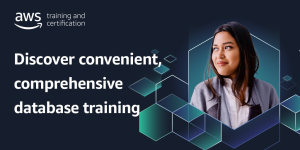AWS Training and Certification Blog
3 ways to go from Database Administrator to Database Innovator
 As organizations re-evaluate their database strategies, they’re rapidly transitioning from on-premises deployments and embracing the cloud model to gain both efficiency and agility. One-size-fits-all relational databases are quickly giving way to purpose-built databases optimized for specific use cases to help enable higher performance and lower costs.
As organizations re-evaluate their database strategies, they’re rapidly transitioning from on-premises deployments and embracing the cloud model to gain both efficiency and agility. One-size-fits-all relational databases are quickly giving way to purpose-built databases optimized for specific use cases to help enable higher performance and lower costs.
This industry-wide transition is hastened by a new generation of developers who are using agile development methodologies. They’re also using continuous integration and continuous delivery (CI/CD) DevOps frameworks that are placing new demands on how databases are architected and deployed.
If you’re a database professional, these fundamental changes present a golden opportunity to expand your database administration to include database innovation.
However, before you can confidently lead the transition to cloud-based, purpose-built, and developer-friendly databases across your organization, you must expand your skill level and knowledge base. Upskilling can help you meet customer expectations at your organization by addressing slow applications, high-cost structures, or general lack of innovation.
To evolve from database administrator to database innovator, you need learning strategies related to three key areas of focus.
1. Moving databases to the cloud
Start by learning about the various options available to migrate your databases to the cloud. Become familiar with the anticipated cost-efficiency and agility advantages, and plan to re-invest the savings into more innovative projects.
AWS Training and Certification offers a wide range of courses, such as Introduction to Database Migration. This free digital course explains how to migrate a production database using the AWS Database Migration Service (AWS DMS) and AWS Schema Conversion Tool (AWS SCT). It introduces you to the full database migration process, all the way from envisioning your project to post-production support. Our new, free digital course, Moving to Managed Databases on AWS, explains the benefits of, and process for, moving from self-managed databases to fully managed database solutions in the cloud. It also explains the process and steps for migrating from seven self-managed databases to AWS database solutions.
2. Selecting from many purpose-built databases
Organizations now have many choices, from open-source databases to commercial offerings spanning relational, graph, in-memory, and other technologies. AWS offers more than 15 purpose-built database engines optimized for a variety of use cases, such as high-traffic web apps, gaming, content management, fraud detection, Internet of Things applications, and more. You can position yourself as an expert by developing the skills to select the right database engines for specific use cases.
For example, our digital course, AWS Database Offerings, provides a basic overview of different database technologies and architectures while introducing you to various AWS database services. This is a free, on-demand course that you can take at your convenience. You can also sign up for a three-day, virtual, instructor-led course, Planning and Designing Databases on AWS, to learn about the process of planning and designing relational and non-relational databases. The course also covers design considerations for hosting databases on Amazon EC2, and you can get your questions answered by an AWS-accredited instructor in real time.
3. Leading the discussion with developers
To be a database innovator, you must also understand the new-generation, cloud- and-mobile-optimized applications that have changed database architectures. First, learn how streaming data, leaderboards, real-time web clicks, graph workloads, and other applications are driving demand for purpose-built databases. Next, review how purpose-built databases facilitate more responsive applications that lead to more engaging customer experiences.
For example, you can take the digital course, Building Highly Connected Applications using Amazon Neptune, to learn how developers can benefit from our graph database.
Building your skills and accelerating your opportunities
The rapidly changing landscape of database technologies offers great opportunities to advance the state of innovation in your organization and future-proof your career. Get started today by accessing a comprehensive set of database-specific AWS Training and Certification resources, including infographic, e-book, digital and classroom courses, webinars, and much more.